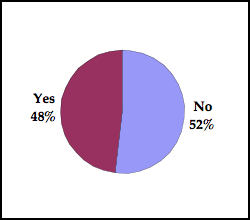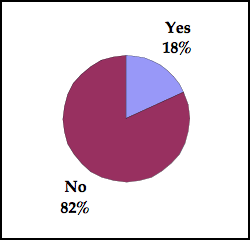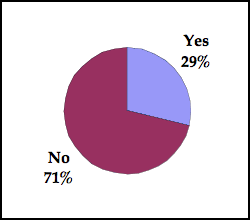When preparing the latest release of Softletter's SaaS (Software as a Service) Report we conducted a series of cross-tabs and drill downs into the results and generated some interesting results we'd like to share with you. In the 2006 report, only 15.4% of our survey respondents replied that they were using Open Source in their product lines. The numbers changed significantly for the 2008 report, with 28% reporting they used Open Source in their SaaS systems. But our drill downs uncovered even more interesting trends we'd like to examine.
Is your SaaS product based on Open Source software?
Companies Under $1M in Revenue

The question is why are smaller SaaS firms turning to Open Source in such large numbers? To gain insight into the issue, we contacted several of our survey respondents and asked them. The answers broke down into two basic categories: cost savings and time to market, a topic we look at in greater detail further on in this article.
When we looked at the $1 to $5m cohort, the numbers shifted dramatically down (results for the $5m to $10m and $10m to $99m segments are similar to those for $1 – $5m):
Companies $1 – $5m in Revenue

Why the sharp drop off in enthusiasm for Open Source amongst these larger firms? Again, we turned to the phones and E-mail. The most common thread running through all the conversations we had was that these companies had made their technology beds at this point and were focused on growing their customer bases, new releases, and solving various sales and marketing issues. Another factor was that while Open Source helped companies build prototypes for proof-of-concept funding and early production systems that helped them reach customer one, as development continued many firms were choosing to take their systems proprietary to achieve scalability and performance goals.
When we looked at the last cohort we measured, the 100m+ segment, the numbers shifted again in favor of Open Source, though not quite so dramatically as with the under $1m segment. When we spoke to management at several large SaaS firms, a common thread running through our conversations was that these companies saw Open Source as an infrastructure play, a means of shaving cost off server management and application serving. The major secondary reason offered was decreased development and component costs.
Companies $100m+ in Revenue

In order to discover more about the relationship between SaaS development trends and Open Source, we contacted Wayne Hom, CTO of Augmentum, a major outsourcer and development house focusing on resources from China. Augmentum recently finished a major development effort for Etology, a SaaS-based firm that creates a virtual ad marketplace for niche publications (such as Softletter).
Wayne, our recent Softletter SaaS survey indicated that almost 50% of SaaS companies under $1M in revenue were basing their products on Open Source software. What is your take on this trend?
Open Source can definitely assist a startup in getting to market faster. With SaaS, time to market and reliable delivery of services is key because of the extended ramp up to profitability.
Where Open Source truly shines is in its ability to function as a community-driven store of components that can drive a new product's underlying architecture. In this sense, Open Source replicates, but on a non-proprietary scale, the platforms being assembled by firms such as Salesforce.com and Netsuite. A new company looking to get up and running can rummage through a vast array of Open Source projects and often find valuable resources that can substantially speed their initial development efforts.
How do you know you'll be able to find what you need from the Open Source parts bin?
Open Source is very dynamic. Our business focus is on China because of the number of new engineers and architect-level personnel being turned out by their educational system. In terms of sheer volume, China is 10X India in the technical resources it's producing. We have a dedicated team at Augmentum for tracking the Chinese market in terms of Open Source technology; we're almost always able to find useful components and systems for our clients.
We've discussed Etology; how did you use Open Source to speed up their time to market?
The key technology underlying their entire system is an ad server. We used phpAdsNew (now OpenX) as the basic server engine. There wasn't a good proprietary technology we could use and if we'd had to write an ad server from scratch, it would have taken approximately six months. From the time the project was spec'd out to launch was 45 days.
Was the product in its original configuration suitable for commercial use?
No, and that's a critical point when considering using Open Source to get to market more quickly. Open Source can save you time and money when you're thinking about acquiring customer one, prototyping, or building a proof-of-concept version of your system for funding efforts. But I have never seen a single instance where an Open Source technology didn't need substantial reworking and proprietary extension for commercial use.
For example, phpAdsNew in its original configuration didn't have strong fraud detection capabilities; we had to rip out that part of the product and put in something new. Even more significant is that while the product performed OK, it couldn't scale sufficiently as Etology's business grew. By the time the company's website was serving two billion ad impressions per day, we had rewritten the entire system in C++ for performance.
In our experience, while Open Source can get you to market more quickly, once you're up and running, ongoing maintenance/development costs are no different from commercial software. Also, when considering using an Open Source technology for a project, you should remember that while the functionality may be there and the cost is very attractive, once you crack open the code, you may find it's not very good. This is not a criticism of the programmers per se. The group or person involved may have wanted to prove a concept or arrive at a quick and dirty solution to a problem. If there was no incentive or reason for them to spend time optimizing their work, you should assume it hasn't been. This is particularly true of smaller and less well publicized Open Source projects.
What about leveraging the Open Source community as the product in its original configuration suitable for commercial use?
There are practical problems with this. One is that companies do not want to contribute back to the community; they want to take, not give. Interestingly enough, they'd love to pay in many cases for the technology. Avoiding the GPL is not usually a question of greed; it's driven more by a desire to focus on business and avoid the distractions and legal issues the GPL introduces into a business.
The other issue facing community use is that even once you've contributed back, Open Source development is a meandering process. The community may or may not contribute and they'll focus on what interests them, not on your business priorities.
 (The data in this article is derived from Softletter's 2008 SaaS Report, available directly from
www.softletter.com. The complete table of contents and preview pages can be
(The data in this article is derived from Softletter's 2008 SaaS Report, available directly from
www.softletter.com. The complete table of contents and preview pages can be